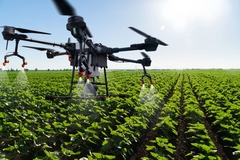Life cycle analysis of potato cultivars poised to tackle post-harvest losses while ensuring year-round supply
15 Jan 2024 --- Scientists at the United States Department of Agriculture (USDA) have investigated the lifecycle of potatoes to help the potato industry maintain the post-harvest quality and prevent post-harvest crop losses, majorly caused by physiological and disease-related processes (10-15%). The method is poised to ensure a year-round supply of the in-demand crop for snack food processing facilities, restaurants, and grocery stores.
The technique studies the crop’s development, production and post-harvest storage to address post-harvest physiological challenges in potatoes while also exploring advanced potato breeding material for post-harvest storage, food quality, and safety characteristics.
"Climate and disease challenges vary across the US. In the Eastern potato growing regions, internal heat necrosis and other defects are increasing in frequency due to hotter growing seasons," Dr. Paul Collins with ARS’ Genetic Improvement for Fruits and Vegetables Lab in ME (Potato Variety Development for the Eastern US) tells Food Ingredients First.

"Seed growers are seeing increasing Potato Virus Y infection and table market growers are challenged by common scab (Streptomyces sp.). Late blight (Phytophthora infestans) continues to be a serious threat. Soft rot, caused by Dickyea dianthicola and Pectobacterium carotovorum, greatly limits the storage life of potatoes."
For the study, the scientists are currently analyzing four Russet potato cultivars (Russet Burbank, Umatilla Russet, Bannock Russet and Dakota Russet) under controlled environmental conditions for dormancy progression and sprout growth patterns during post-harvest storage.
 Currently, no method is completely able to prevent physical deterioration of potato tubers during storage.
Currently, no method is completely able to prevent physical deterioration of potato tubers during storage.
Post-harvest concerns
Potatoes are one of the main crops grown in the US, with a production of approximately 22.5 million tons annually, notes the study, with fall being the primary season for harvesting potatoes, accounting for 90% of the total output.
Since many locations cannot support year-round potato cultivation, most potatoes intended for processing, such as frozen French fries or instant mashed potatoes, are harvested in the fall and safely stored until needed. Storing and maintaining potatoes at their top nutritional quality while meeting consumer and market demands is essential for the industry.
“Currently, there is no method that is 100% efficient to control the physical deterioration of the potato tubers during storage," underscores Dr. Munevver Dogramaci, a research plant physiologist and lead scientist of the Potato Research Program at the Edward T. Schafer Agricultural Research Center in North Dakota, US, which is conducting the study.
“Potato tubers are at their peak nutritional quality during harvest, but storing them under specific conditions is essential to maintain this quality.”
She explains that a better understanding of physiological processes will help scientists improve post-harvest storage methods, preserving nutritional value, processing quality and the marketability of potatoes.
Some key challenges faced by potato growers include early sprouting and slow wound healing of potato tubers inadvertently damaged during the operational process.
Potatoes are also prone to diseases during storage and post-harvest when unintended wounding of tubers might occur. “This results in rapid quality loss that impacts the tuber’s texture and ability to retain water,” Dr. Dogramaci explains.
Crafting super potatoes
Dr. Collins is working to develop new varieties for chip processing and table markets with enhanced agronomic attributes, disease resistance, climate resilience and quality traits.
"As a participant and coordinator for the National Chip Processing Trials (NCPT), organized by Potatoes USA, my research program submits promising chipping potato clones to be evaluated for commercial potential," he tells us.
"In addition to extensive testing on yield and other agronomically important traits throughout the US, the most promising clones from NCPT are tested by large processors and are evaluated for processing quality. Factors such as shape, specific gravity, resistance to bruising, and resistance to internal defects all affect the quality of the potato chips that Americans consume. "
When selecting a new chipping variety, the study's aim is to identify clones which are profitable to the farmer and the processors, while providing a high-quality potato chip to the consumer.
 Early sprouting and slow wound healing of potato tubers are key challenges faced by potato producers.Potato breeding seeks to identify new potato varieties that can benefit the value chain. "Processors and retailers are interested in maintaining quality and uniformity,” he states, adding that for consumers, improved nutrition and flavor matter.
Early sprouting and slow wound healing of potato tubers are key challenges faced by potato producers.Potato breeding seeks to identify new potato varieties that can benefit the value chain. "Processors and retailers are interested in maintaining quality and uniformity,” he states, adding that for consumers, improved nutrition and flavor matter.
The program previously developed Atlantic, a variety widely grown across the US for potato chips and is within the top ten most popular potato varieties in the region.
Last year, researchers compiled the data from genome sequences of 296 varieties of potatoes and wild versions of 60 species to work toward improving potato germplasm for climate resilience and safeguarding food security. They used the findings to recognize genetic traits that would make the crop more resilient to stresses such as heat, drought and cold snaps, which are frequently increasing with climate change.
By Insha Naureen













